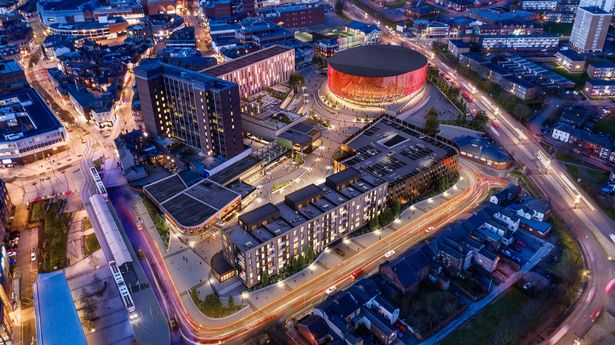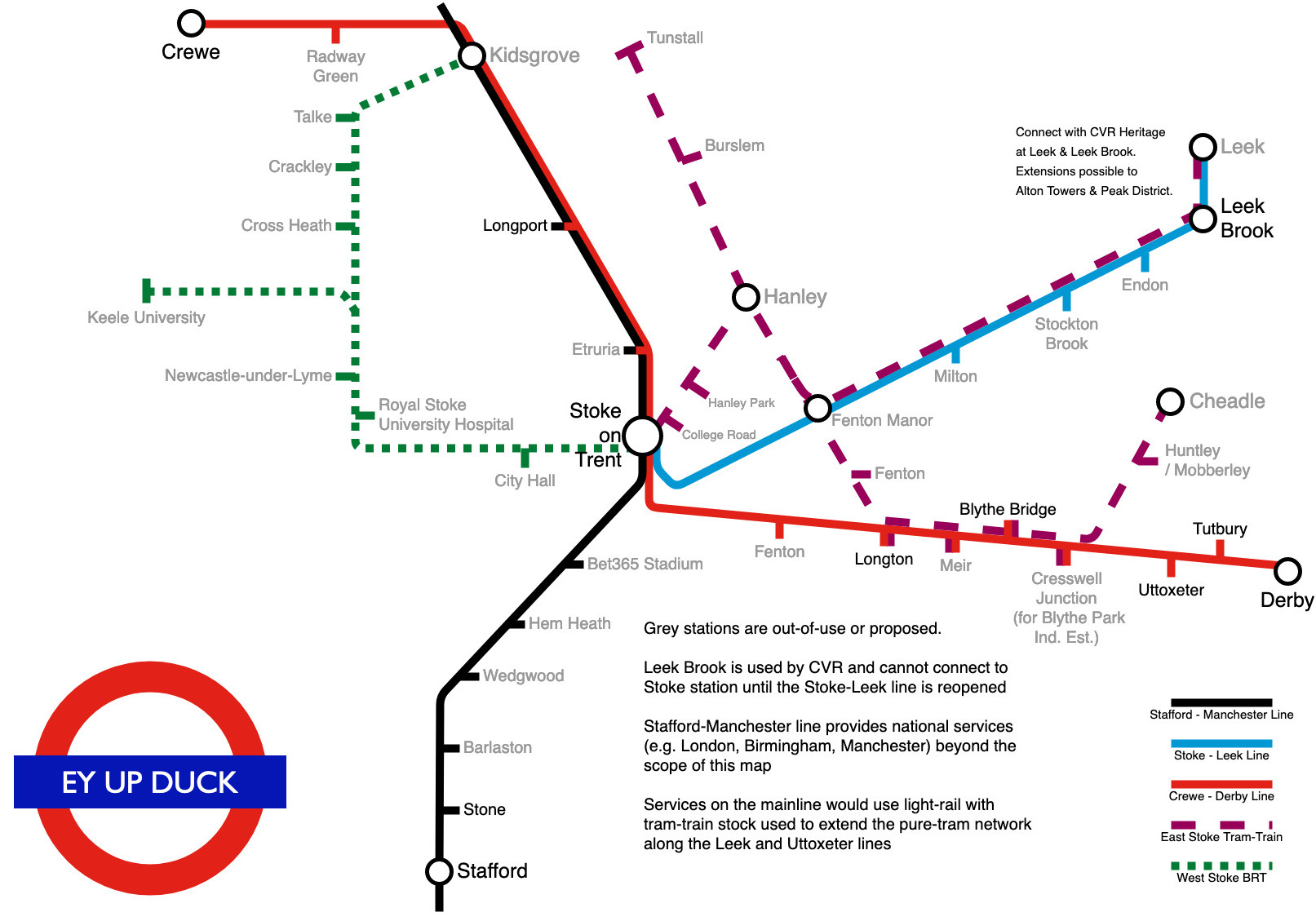Rail for Stoke
Stoke-on-Trent council are full of big ideas at the moment, announcing a major redevelopment in Hanley (where else?), which includes proposals for a tram network. None of this should be taken too seriously of course - no funding is yet in place and the proposals are for a site which has stood vacant for many years, with past developers and projects already having fallen through.

In general I’m not a huge fan of trams as they are often introduced to common street areas. Whilst a huge fan of public transit, the introduction of rails to the street rather than in dedicated tramways can present a significant hazard for cyclists. They’re also relatively expensive (£20-30m/km) compared to Bus Rapid Transit (<£10m/km). BRT can provide all the same benefits but tends to get value-engineered back down to just “bus” by the time the project is delivered. The need for dedicated infrastructure like sticking steel rails in the street seems to be the only way to stop politicians and accountants fiddling!
In Stoke’s case however, I think trams have some legs. Stoke is a poly-centric city with no real core. Arguably, this is one of the underlying reasons for its poor economic performance - successive councils have struggled to deliver a single cohesive development plan when the five towns are all demanding their share. Just consider that Hanley - undoubtedly the city’s retail hub - has no decent transport access from the A50 or A500, nor from the main rail station. And we haven’t yet considered Newcastle and Keele who clearly sit within the area’s economic sphere but will firmly insist they are definitely not part of Stoke!
A tram or BRT network could help unify Stoke’s towns as well as reduce the city’s famously bad congestion. Importantly however, Stoke already has two rail branch lines which could be recruited into a Tram-Train system, extending the core of a new-build tram network quickly and cheaply. Pioneered in Germany, Sheffield’s “SuperTram” has now proven Tram-Train in a UK context.
What’s there and what’s not
Stafford-Manchester Line
Stoke has a lot of opportunity coming in the next 10 years. With HS2 Phase2, non-stop express trains will bypass Stafford and Stoke. The line through Stoke station will only carry trains actually stopping there. This has the potential to free up many train-paths for local services. For instance, there is only one train-per-hour from Stone to Stoke. This could become a regular shuttle with 3-4tph. Additional stations at Barlaston, Trentham, the Bet365 Stadium and Etruria could also be (re-)opened once inter-city express services are no longer barreling through at 130mph.l
Crewe-Derby
Despite major overcrowding at peak times, the Crewe-Derby line (currently stopping at Kidsgrove, Longport, Stoke, Longton, Blythe Bridge, Uttoxeter & Tutbury) runs just 1tph, mainly due to lack of capacity on the mainline through Stoke where small shuttle trains have to dodge the 130mph express services. This leaves significant capacity for local rail or tram-train services east of Stoke station. Proposals have also been made to reopen Meir station, providing more connectivity within Stoke. Increased Crewe-Derby (end-to-end) services will be facilitated by HS2 offloading fast traffic.
Stoke-Leek
The Stoke-Leek line was mothballed in 1988 and has been identified as a Priority 1 candidate for reopening by Better Transport. Winding past Bucknall, Milton, Stockton Brook and Endon it would also reconnect the Churnet Valley Railway’s Heritage line to the national network and permit the reintroduction of freight services from Peak District quarries, reducing HGV movements. Stoke reporter Tom Burnett mused whether the proposed Tram network could use the line to reach Leek. It certainly could, but it would make more sense to open the line for conventional rail and then specify the new Trams to operate as a Tram-Train system. You can have your cake and eat it!
Stoke & Newcastle
The Stoke-Market Drayton line which served Keele, Newcastle and Silverdale was only closed in 1998, but short-sighted development has already seen the infilling of one tunnel to support residential and light-industrial development, significantly complicating re-opening (tunnelling costs at least £40m/km before any rails or infrastructure are laid). It may be possible for Newcastle to develop a tram-train network where the old alignment still exists west of Stoke, with the intention of connecting to Stoke station in the future. This would require careful planning to ensure compatibility. The old railway also goes nowhere near Keele University - an obvious node on any new network - necessitating significant new-build. In the shorter term, a BRT with some dedicated bus roadways would offer a cheap and effective way of connecting Stoke station with the Royal Stoke Hospital, Newcastle-under-Lyme and Keele University. Such roadways might also be convertible to tramways in future. With the current emphasis on work-from-home and reduction in car traffic, this would be an ideal time to look at changing road layouts to favour mass-transit.
Cheadle
Cheadle was served by rail from Cresswell Junction, which is also next to an otherwise-rural, car-first industrial estate with little public transport provision. Although the trackbed is long since gone (unlike the Leek line), the alignment remains largely intact apart from at the Cheadle end where an act of vandalism has seen a housing estate with road names such as “The Sidings” and “Pullman Court” plonked atop it. A new alignment into Cheadle proper would be needed, but this is entirely possible.
A Cheadle-Stoke tram-train or light-rail service would serve as a sensible edge to the Stoke Metro area, which would otherwise probably run out at Blythe Bridge (or Uttoxeter if one pushed the boat out).
The existing alignment is ~6km. Depending on whether the land remains in public hands or has been sold off, track cost could be less than £50million to rebuild - more of course is land must be reacquired. To keep costs down, such a branch could be easily served by a single line, with a passing loop halfway up. The terminus need only be single-platform.
A more ambitious scheme of course could see a “left hand” turn introduced at the bottom, permitting conventional rail services Eastwards to Uttoxeter and beyond. Stoke Council however would only be concerned with the Stoke-bound direction, and passengers could change for East-bound trains at Blythe Bridge.
The Grand Plan
There are several aspects to this. Forefront are facilities like Meir station which exist on an operational line. Second must be extant mothballed infrastructure like the Stoke-Leek line which have already been scrutinised and can be renovated into service relatively cheaply. Reinstatement of the Cheadle line and new-build like the Hanley Tram is then more speculative, and new stations along the mainline are contingent on HS2 freeing up train paths to service them.
What is perhaps most important is that a cohesive brand and ticketing mechanism is implemented. A passenger should be able to buy a ticket from Uttoxeter to Keele or Hanley and transition from a train to Tram or BRT using that single ticket. There is no space for mini-fiefdoms here nor arbitrary distinctions between Newcastle and Stoke. This must be “Potteries Transit”.
It could look something like this:

The exciting part of this map is that most of it is already in place. Two of the three rail lines are operational whilst the Stoke-Leek line “just” needs refurbishment. We’re primarily waiting on HS2 to free up running space on the Stafford-to-Manchester line. BRT could - in principle - be evolved gradually from existing Bus services (albeit with the risk that value-engineering means actual BRT is never properly delivered).
The big expense is the Tram. Tunstall to Longton is ~10km. Using a rule-of thumb of £20-30m/km, that’s a huge £250m project - instating both BRT and the Leek-Stoke line would cost a fraction of that and must be the priority. But it would offer travel times of ~20minutes from Tunstall to Longton, which would be a game-changer in connecting up Stoke’s Five Towns in a cohesive manner and would be faster than driving most of the time. It also highlights the benefits of using a Tram-Train architecture to extend the network out to Meir and Blythe Bridge almost for free.
There’s a lot of unused and underused infrastructure lying around Stoke, and it’s high time it was put to good use. Some of the proposals are big and flagship, but others (like reopening stations) can almost be found from normal annual expenditure, requiring no special fundraising or finance. We can only hope that the Council seek to put together a cohesive strategy and don’t scale back to flashy - but isolated - flagship projects. Transport is all about interconnects and allowing the network to become greater than the sum of its parts.